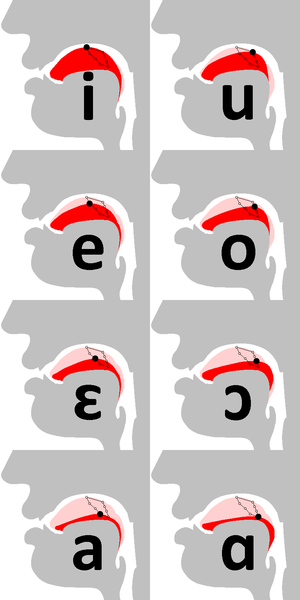Dysarthria: Difference between revisions
mNo edit summary |
mNo edit summary |
||
| Line 57: | Line 57: | ||
== Resources == | == Resources == | ||
[https://www.asha.org/PRPSpecificTopic.aspx?folderid=8589943481§ion=Overview American Speech-Language-Hearing Association] | |||
== References == | == References == | ||
<references /> | <references /> | ||
Revision as of 13:23, 26 October 2020
This article is currently under review and may not be up to date. Please come back soon to see the finished work! (26/10/2020)[edit | edit source]
Clinically Relevant Anatomy[edit | edit source]
Dysarthria pertains to a category of neurogenic speech disorders distinguished by anomaly in the strength, speed, availability, stableness, tone, or accuracy of movements necessary for breathing, phonatory, resonatory, articulatory, or prosodic features of speech creation[1].
These anomalies are the result of one or several sensorimotor issues, including weakness or paralysis, incoordination, involuntary movements, or immoderate, declined, or inconstant muscle tone[1]. Dysarthria can negatively impact the comprehensibility of speech, realism of speech, or both. It is necessary to be aware that intelligence can be normal in some speakers with dysarthria. Dysarthria might co-exist with other neurogenic language, cognitive, and swallowing disorders[2].
Mechanism of Injury / Pathological Process[edit | edit source]
Damage to the nervous system causes hypotonicity in the muscles that create speech sounds. This may impact the muscles in one or several of the following areas:
- Face
- Lips
- Tongue
- Throat
- Upper respiratory tract
The neurological damage that can result in dysarthria can be from[1]:
- Congenital: cerebral palsy, Chiari malformation, congenital suprabulbar palsy, syringomyelia, syringobulbia.
- Degenerative diseases: amyotrophic lateral sclerosis (ALS), Parkinson's disease, progressive supranuclear palsy, cerebellar degeneration, corticobasal degeneration, multiple system atrophy, Friedreich's ataxia, Huntington's disease, olivopontocerebellar atrophy, spinocerebellar ataxia, ataxia telangiectasia.
- Demyelinating and inflammatory diseases: multiple sclerosis, encephalitis, Guillain-Barré and associated autoimmune diseases,meningitis, multifocal leukoencephalopathy.
- Infectious diseases: acquired immune deficiency syndrome (AIDS), Creutzfeldt-Jakob disease, herpes zoster, infectious encephalopathy, central nervous system tuberculosis, poliomyelitis.
- Neoplastic diseases: central nervous system tumors; cerebral, cerebellar, or brainstem tumors; paraneoplastic cerebellar degeneration.
- Other neurologic conditions: hydrocephalus, Meige syndrome, myoclonic epilepsy, neuroacanthocytosis, radiation necrosis, sarcoidosis, seizure disorder, Tourette's syndrome, Chorea gravidarum
- Toxic/metabolic diseases: alcohol, botulism, carbon monoxide poisoning, central pontine myelinolysis, heavy metal or chemical toxicity, hepatocerebral degeneration, hypothyroidism, hypoxic encephalopathy, lithium toxicity, Wilson's disease.
- Trauma: traumatic brain injury, chronic traumatic encephalopathy, neck trauma, neurosurgical/postoperative trauma, skull fracture.
- Vascular Diseases: stroke (hemorrhagic or nonhemorrhagic), Moyamoya disease, anoxic or hypoxic encephalopathy, arteriovenous malformations.
Incidence and Prevalence[2][edit | edit source]
- Stroke: Estimated that 8%–60% of patients with stroke present with dysarthria.
- Traumatic brain injury: Approximately 10%–65% of patients post traumatic brain injury have dysarthria.
- Parkinson's disease: Estimation that dysarthria impacts approximately 70%–100% of patients post Parkinson's disease.
- Multiple sclerosis: Admist 25% and 50% of patients with multiple sclerosis show with dysarthria at some stage during the continuity of their disease.
- Amyotrophic lateral sclerosis: Dysarthria can be seen as an initial symptom in up to 30% of patients with this condition, with relatively all patients developing dysarthria in later stages.
Clinical Presentation[edit | edit source]
add text here relating to the clinical presentation of the condition
Diagnostic Procedures[edit | edit source]
add text here relating to diagnostic tests for the condition
Outcome Measures[edit | edit source]
add links to outcome measures here (see Outcome Measures Database)
Management / Interventions[edit | edit source]
add text here relating to management approaches to the condition
Differential Diagnosis[edit | edit source]
add text here relating to the differential diagnosis of this condition
Resources[edit | edit source]
American Speech-Language-Hearing Association
References[edit | edit source]
- ↑ 1.0 1.1 1.2 Duffy JR. Motor Speech Disorders: Substrates, Differential Diagnosis, and Management, 3rd edn. St. Louis, MO: Elsevier, Mosby. 2013.
- ↑ 2.0 2.1 American Speech-Language-Hearing Association. Dysarthria in Adults. Available from: https://www.asha.org/PRPSpecificTopic.aspx?folderid=8589943481§ion=Overview [accessed 26 October 2020].







